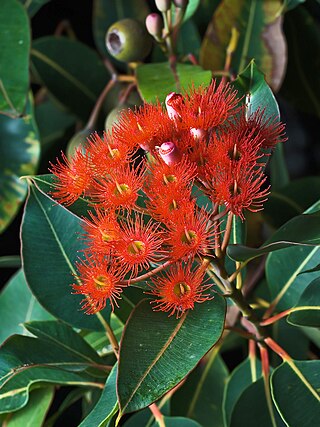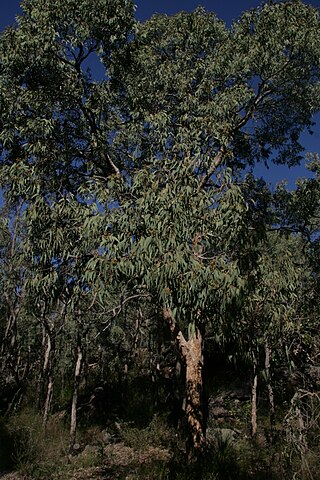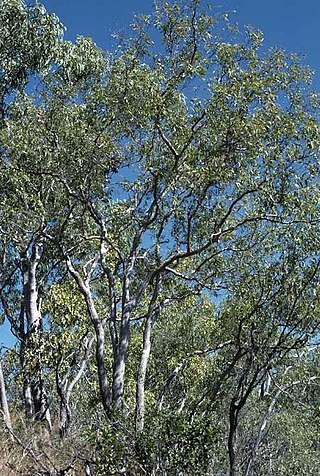
Eucalyptus is a genus of more than 700 species of flowering plants in the family Myrtaceae. Most species of Eucalyptus are trees, often mallees, and a few are shrubs. Along with several other genera in the tribe Eucalypteae, including Corymbia and Angophora, they are commonly known as eucalypts. Plants in the genus Eucalyptus have bark that is either smooth, fibrous, hard or stringy, the leaves have oil glands, and the sepals and petals are fused to form a "cap" or operculum over the stamens. The fruit is a woody capsule commonly referred to as a "gumnut".

Corymbia, commonly known as bloodwoods, is a genus of about one hundred species of tree that, along with Eucalyptus, Angophora and several smaller groups, are referred to as eucalypts. Until 1990, corymbias were included in the genus Eucalyptus and there is still considerable disagreement among botanists as to whether separating them is valid. As of January 2020, Corymbia is an accepted name at the Australian Plant Census.

Corymbia ficifolia, commonly known as red flowering gum, is a species of small tree that is endemic to the south-west of Western Australia. It has rough, fibrous bark on the trunk and branches, egg-shaped to broadly lance-shape adult leaves, flower buds in groups of seven, bright red, pink or orange flowers and urn-shaped fruit. It has a restricted distribution in the wild but is one of the most commonly planted ornamental eucalypts.

Myrtaceae, the myrtle family, is a family of dicotyledonous plants placed within the order Myrtales. Myrtle, pōhutukawa, bay rum tree, clove, guava, acca (feijoa), allspice, and eucalyptus are some notable members of this group. All species are woody, contain essential oils, and have flower parts in multiples of four or five. The leaves are evergreen, alternate to mostly opposite, simple, and usually entire. The flowers have a base number of five petals, though in several genera, the petals are minute or absent. The stamens are usually very conspicuous, brightly coloured, and numerous.

Metrosideros is a genus of approximately 60 trees, shrubs, and vines mostly found in the Pacific region in the family Myrtaceae. Most of the tree forms are small, but some are exceptionally large, the New Zealand species in particular. The name derives from the Ancient Greek metra or "heartwood" and sideron or "iron". Perhaps the best-known species are the pōhutukawa, northern and southern rātā of New Zealand, and ʻōhiʻa lehua, from the Hawaiian Islands.

Angophora is a genus of nine species of trees and shrubs in the myrtle family, Myrtaceae. Endemic to eastern Australia, they differ from other eucalypts in having juvenile and adult leaves arranged in opposite pairs, sepals reduced to projections on the edge of the floral cup, four or five overlapping, more or less round petals, and a papery or thin, woody, often strongly ribbed capsule. Species are found between the Atherton Tableland in Queensland and south through New South Wales to eastern Victoria, Australia.

Eugenia is a genus of flowering plants in the myrtle family Myrtaceae. It has a worldwide, although highly uneven, distribution in tropical and subtropical regions. The bulk of the approximately 1,100 species occur in the New World tropics, especially in the northern Andes, the Caribbean, and the Atlantic Forest of eastern Brazil. Other centers of diversity include New Caledonia and Madagascar. Many of the species that occur in the Old World have received a new classification into the genus Syzygium.

Corymbia calophylla, commonly known as marri, is a species of flowering plant in the family Myrtaceae and is endemic to the southwest of Western Australia. It is a tree or mallee with rough bark on part or all of the trunk, lance-shaped adult leaves, branched clusters of cup-shaped or pear-shaped flower buds, each branch with three or seven buds, white to pink flowers, and relatively large oval to urn-shaped fruit, colloquially known as honky nuts. Marri wood has had many uses, both for Aboriginal people, and in the construction industry.
Allosyncarpia ternata, commonly known as an-binik, is a species of rainforest trees constituting part of the botanical family Myrtaceae and included in the eucalypts group. The only species in its genus, it was described in 1981 by Stanley Blake of the Queensland Herbarium. They grow naturally into large, spreading, shady trees, and are endemic to the Northern Territory of Australia. They grow in sandstone gorges along creeks emerging from the Arnhem Land plateau.

Corymbia citriodora, commonly known as lemon-scented gum and other common names, is a species of tall tree that is endemic to north-eastern Australia. It has smooth white to pink bark, narrow lance-shaped to curved adult leaves, flower buds in groups of three, white flowers and urn-shaped or barrel-shaped fruit.

Angophora costata, commonly known as Sydney red gum, rusty gum or smooth-barked apple, is a species of tree that is endemic to eastern Australia. Reaching 30 m (100 ft) in height, the species has distinctive smooth bark that is pinkish or orange-brown when new and fades to grey with age. Its lance-shaped leaves are arranged in opposite pairs along the stems, with white or creamy white flowers appearing from October to December. The flower buds are usually arranged in groups of three, followed by ribbed, oval or bell-shaped fruit.

Angophora hispida grows as a mallee, or as a tree to about 7 m (25 ft) in height. A. hispida's small size, especially when compared to its Angophora and Eucalyptus relatives, leads to it being known by the common name dwarf apple. It is native to a relatively small patch of central New South Wales – from just south of Sydney up to the Gosford area. The plant's leaves are sessile (stalk-less) and hug the stem with heart-shaped bases. Its previous name – A. cordifolia – referred to these cordate leaves. Another distinctive feature are the red bristly hairs that cover the branchlets, flower bases and new growth. This leads to the specific epithet hispida.

Corymbia intermedia, commonly known as pink bloodwood, is a species of medium to tall tree that is endemic to north-eastern Australia. It has rough, tessellated bark on the trunk and branches, flower buds in groups of seven, white flowers and oval to barrel-shaped fruit.
Eucalyptopsis is a genus of describing two species of trees, constituting part of the plant family Myrtaceae and included in the eucalypts group. They have botanical records of growing naturally in New Guinea and the Moluccas, within the Malesia region. Plant geneticists have found their closest evolutionary relatives in the monotypic genera and species Stockwellia quadrifida and Allosyncarpia ternata.

Angophora floribunda, commonly known as the rough-barked apple, is a common woodland and forest tree of the family Myrtaceae native to Eastern Australia. Reaching 30 m (100 ft) high, it is a large tree with fibrous bark and cream-white flowers that appear over the Austral summer. It grows on alluvial soils on floodplains and along watercourses. Much of the land it grew on has been cleared for agriculture.

Corymbia eximia, commonly known as yellow bloodwood, is a bloodwood native to New South Wales. It occurs around the Sydney Basin often in high rainfall areas on shallow sandstone soils on plateaux or escarpments, in fire prone areas. Growing as a gnarled tree to 20 m (66 ft), it is recognisable by its distinctive yellow-brown tessellated bark. The greyish green leaves are thick and veiny, and lanceolate spear- or sickle-shaped. The cream flowerheads grow in panicles in groups of seven and appear in spring. Known for many years as Eucalyptus eximia, the yellow bloodwood was transferred into the new genus Corymbia in 1995 when it was erected by Ken Hill and Lawrie Johnson. It is still seen under the earlier name in some works.

Stockwellia is a monotypic genus in the flowering plant family Myrtaceae. The sole species in the genus, Stockwellia quadrifida, is endemic to Queensland.

Corymbia jacobsiana, commonly known as Jacob's bloodwood or stringybark bloodwood, is a species of tree that is endemic to the Northern Territory. It has rough, stringy bark on the trunk and branches, lance-shaped to elliptical or curved adult leaves, flower buds in groups of three or seven, creamy white flowers and urn-shaped fruit.

Eucalypteae is a large tribe of flowering plants in the family Myrtaceae; members of this tribe are known as eucalypts. In Australia the genera Angophora, Corymbia, and Eucalyptus are commonly known as gum trees, for the sticky substance that exudes from the trunk of some species. As of 2020, the tribe comprised around 860 species, all native to Southeast Asia and Oceania, with a main diversity center in Australia.
Frank Udovicic is an Australian botanist who specialises in molecular systematics and phytogeography.
















